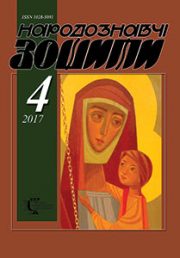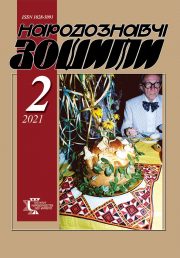The Ethnology Notebooks. 2025. № 5 (185), 1126—1139
UDK[398.21:398.34:27-185](=1:100):930.2
PROTECTIVE MAGIC OF THE EGG IN CUSTOMS AND RITES RELATED TO THE ROOF OF A BUILDING
RAKHNO Kostyantyn
- ORCID ID: https://orcid.org/0000-0002-0973-3919
- Doctor of History, Associate Professor,
- Leading Researcher of the National Museum
- of Ukrainian Pottery in Opishne,
- 102, Vyacheslava Chornovola Street, 38164, Opishne, Ukraine,
- Contacts: e-mail: krakhno@ukr.net
Abstract. The egg as an image or symbol of the integral structure of the world and man is found in many cosmogonic legends and legends about the creation of the Earth. Thus, the myths of different peoples and cultures describe the process of the birth of the world from an egg. At the same time, the egg is endowed with a certain symbolism, it is a symbol of integrity, the birth of life, rebirth, immortality, etc., which acts as a talisman. The purpose of the article is to explore the idea of the protective magic of the egg in the rites and customs associated with the roof of a building among different peoples of the world. The object of the study is ethnographically recorded examples of the use of the egg as a magical protection of the roof. The roof was conceived as a sacred part of the house, which protected its inhabitants and at the same time was a place of contact with supernatural forces. In turn, the egg was considered an inanimate object that hid life in itself, and with life — strength and health, which, according to the ideas of primitive people, could be transferred to other objects or beings. It was believed that the life force contained in them stimulates the growth of people, livestock and field crops, and also protects against witches, lessons, diseases and fire. The methodological basis of the study is a comparative-historical methodological toolkit.
The basis of the work are ethnographic materials concerning the perception of the egg as a roof mascot in traditional culture. The results of the research are that the egg was a sacred symbol in many religions, signifying the transition from non-existence to existence, birth and rebirth. It was actively used in various rites and rituals, including those that took place on the roof. Eggs, mainly consecrated for the spring holidays of the resurrection of nature, acted as a powerful talisman for the house and its roof, although they had an ambivalent nature. Some eggs, which were abnormally small in size, were considered threatening, and people tried to eliminate this threat, motivated by mythology. In the mythology of many ancient peoples, from Egypt to Oceania, the egg symbolized the secret of the creation of the world from the primordial chaos and the ideal microcosm. The egg itself, which arose either by itself or was laid in the ocean by a huge fantastic bird or snake, splitting, became the source of life on Earth, sometimes even giving birth to gods and the first people. Therefore, there was a belief that a household spirit or a completely dangerous mythological creature could be hatched from an egg.
Keywords: customs, beliefs, rituals, folk religiosity, roof, mythology, traditional culture.
Received 20.06.2025
REFERENCES
- Messa, M. (1999). Halk Pillar as a Decorative and Protective Element of the Traditional Folk Architecture of Some Regions of Slovakia. Traditions of the Building and Housing in Slovakia with a Special Accent for Cultural Speeches in the Environment of Ethnic Minorities (Pp. 226—232). Bratislava; Svidnik: EXCO s. r. o. [in Slovak].
- Schwenk, K. (1851). The Symbols of Ancient Peoples. Frankfurt am Main: J.D. Sauerländer’s Publishing House [in German].
- Gimbutas, M. (1989). The Language of the Goddess. London: Thames and Hudson.
- Bachofen, J.J. (1926). Primal Religion and Ancient Symbols: Systematically Arranged Selections from His Works in Three Volumes (Vol. 1). Leipzig: Philipp Reclam Jr. Publishing House [in German].
- Wildhaber, R. (1960). On the Symbolic Content and Iconography of the Egg. German Yearbook of Folklore, 6, 77—84 [in German].
- (1911). Complete Collection of Russian Chronicles. Russian Chronograph. Part one. Chronograph of the 1512 Edition (Vol. XXII). Saint Petersburg: M.A. Alexandrov’s Printing House [in Russian].
- Wolff, Th. (1902). Folk Life on the Upper Nahe. Journal of the Folklore Society, 12, 418—429 [in German].
- Andree-Eysn, M. (1910). Folklore from the Bavarian-Austrian Alpine Region. Braunschweig: Printed and published by Friedrich Vieweg and Son [in German].
- Meyrhofer, K. (1927). Ancestral Heritage: On Customs and Traditions in Old Bavaria. Munich; Berlin: Printed and published by R. Oldenbourg [in German].
- Burli, J. (1898). Folklore from the Canton of Lucerne. Swiss Archives for Folklore, 2, 279—282 [in German].
- Geramb, V. (1924). German Customs in Austria: A Book for the Knowledge and Preservation of Good Customs and Traditions. Graz: Publisher of the Alpenland Bookstore Sudmark [in German].
- Frolcova, V. (2001). Easter in Czech Folk Culture. Prague: Vysehrad [in Czech].
- Gratsianskaya, O.A. (1977). Czechs and Slovaks. Calendar Customs and Rites in the Countries of Foreign Europe. XIX — Early XX Century. Spring Holidays (Pp. 221—237). Moscow: Nauka [in Russian].
- Ryzhyk, E. (1997). Calendar Rites of the Ukrainians of Kholm Region and Podlasie. Kholm Region and Podlasie: Historical and Ethnographic Study (Pp. 251—269). Kyiv: Rodovid [in Ukrainian].
- Daniels, C. L. M., Stevens, Ch. McCl. (1903). Encyclopaedia of Superstitions, Folklore, and the Occult Sciences of the World: A Comprehensive Library of Human Belief and Practice in the Mysteries of Life. Milwaukee: J.H. Yewdale & Sons Company.
- Novikov, Yuri. (2009). Folklore of the Old Believers of Lithuania: Texts and Studies. Folk Mythology. Beliefs. Everyday Magic (Vol. 2). Vilnius: Publishing House of Vilnius Pedagogical University [in Russian].
- Dyer, T. F. T. (1876). British Popular Customs, Present and Past; Illustrating the Social and Domestic Manners of the People: Arranged According to the Calendar of the Year. London: George Bell and Sons.
- Bourke, J.G. (1913). The Debris in the Customs, Traditions, Beliefs, and Customary Law of Nations. Leipzig: Ethnological Publishing House [in German].
- Sibley, J.T. (2009). The Divine Thunderbolt. Bloomington: Xlibris Corporation.
- Levkievskaya, Ye.Ye. (1996). Slavic Ideas about the Methods of Communication between This and That World. The Concept of Movement in Language and Culture (Pp. 185—212). Moscow: Indrik [in Russian].
- Hoffmann-Krayer, E. (1913). Festivals and Customs of the Swiss People. Zurich: Printed and published by Schulthetz & Co. [in German].
- Stoll, O. (1908—1909). On the Knowledge of Magical Beliefs, Folk Magic, and Folk Medicine in Switzerland. Annual Reports of the Geographical-Ethnographic Society in Zurich, 9, 37—208 [in German].
- Hofler, M. (1906). The Heart as a Formed Bread. Archives of Anthropology, V, 263—275 [in German].
- Klinger, W. (1909). The Egg in Folk Superstition in Our Country and in Antiquity. Proceedings of the Academy of Arts, Faculty of Philology. Series II (Vol. XXX, pp. 162—190). Krakow: Published by the Academy of Arts [in Polish].
- Bronner, F.J. (1908). On German Customs and Traditions. Folk Customs and Traditions in Bavaria and the Neighbouring Regions. Munich: Max Keller’s Publishing House [in German].
- Buisson, E.W. (1924). Folk Beliefs in the Wutach Valley. My Homeland. Baden Journal of Folklore, 6, 133—137 [in German].
- Franziszi, Fr. (1895). The Ontlas Egg. Journal of Austrian Folklore (P. 13) [in German].
- Dahn, F. (1860). Folk Customs. Bavaria: Regional and Folklore Studies of the Kingdom of Bavaria. Upper and Lower Bavaria (Vol. 1, pp. 363—423). Munich: Literary and Artistic Institute [in German].
- Adrian, K. (1944—1945). Wind and Weather in the Beliefs and Customs of Our People. Reports of the Society for Salzburg Regional Studies, 84/85, 1—48 [in German].
- Eysn, M. (1898). The Antlass Egg in Salzburg. Journal of the Society for Folklore, 8, 339—340 [in German].
- Seignolle, C. (2002). Tales about the Devil According to Popular Beliefs. Testimonies Collected by Claude Seignolle (Vol. 1). Moscow: Enigma [in Russian].
- Bellsehan, E. (1925). Contribution to the Knowledge of Folk Medicine in Carinthia: Folk Remedies from the Animal Kingdom. CARINTHIA: Communications of the Association «Natural History State Museum of Carinthia», 114—115, 1—11 [in German].
- (2001). Folk Medicine in Tyrol: An EU Interreg II Project ZDN. Ratingen: VGM-Verlag [in German].
- Waldfreund, J.E. (1855). Folk Customs and Superstitions in Tyrol and the Salzburg Mountains. Journal of German Mythology and Customs, 3, 334—343 [in German].
- Wuttke, A. (1869). Contemporary German Folk Superstitions. Berlin: Wiegand & Grieben [in German].
- Moderndorfer, V. (1948). Faith, Beliefs and Customs of the Slovenes: (Ethnographic Materials). Second book: Holidays. Celje: Printing House of the Society of St. Mohor [in Slovenian].
- (1995). Encyclopedia of Slovak Folk Culture (Vol. 1). Bratislava: Veda [in Slovak].
- Grohmann, J.V. (1864). Superstitions and Customs from Bohemia and Moravia (Vol. 1). Prague: Printed by the Imperial and Royal Court Printing Office of Gottlieb Haase and Sons.
- Eduard, Hoffmann-Krayer, & Hanns, Bachtold-Staubli. (1929—1930). Concise Dictionary of German Superstitions (Vol. 2). C-Frautragen. Berlin; Leipzig: Walter de Gruyter [in German].
- Mogk, E. (1915). The Egg in Folk Customs and Beliefs. Journal of the Association for Folklore, 25, 215—223 [in German].
- Oelschlaeger, P. (2009). Thunderstorm! Norderstedt: Books on Demand GmbH [in German].
- Wolfram, R. (1980). Customs and Folk Beliefs in the Gottschee. Vienna: Self-published by the Austrian Museum of Folklore [in German].
- Shmaida, M. 1992. And I Wish You. Calendar Rituals of the Ruthenians-Ukrainians of Czechoslovakia. Presov: Slovak Pedagogical Publishing House, Department of Ukrainian Literature [in Ukrainian].
- Zelenin, D.K. (1915). Description of the Manuscripts of an Archive of the Imperial Russian Geographical Society (Issue 2). Petrograd: A.V. Orlov’s Printing House [in Russian].
- Baumgarten, А. (1862). From the Popular Tradition of Homeland I: On the Folk Natural History. The Twenty Second Proceedings on the Museum Francisco Carolinum along with the Twenty-Three Issue of Contributions to the Regional Studies of Austria on Ens (Pp. 1—159) [in German].
- Varkhol, N. (2017). Folk Demonology of the Ukrainians of Slovakia. Svidnik: Svidnik Publishing House, Ltd. [in Ukrainian].
- Kaindl, R.F. (1896). The Festival Calendar of the Ruthenians and Hutsuls. Proceedings of the Royal and Imperial Geographical Society (Vol. XXXIX, pp. 401—446) [in German].
- Kolbe, W. (1888). Hessian People’s Customs and Traditions in the Light of the Pagan Era. Marburg: N.G. Elwert’s Printing House and Book Trade [in German].
- Hofler, M. (1909). Figured Breads at the Birth, Puerperium and Baptism Celebrations (Birth and Name Day). Journal of Austrian Ethnology (Vol. XV, pp. 81—111) [in German].
- Munkacsi, B. (1893). Popular Beliefs of the Votyaks. At the Original Source (Vol. IV, pp. 88—91) [in German].
- Owen, E. (1896). Welsh Folk-Lore: a Collection of the Folk-Tales and Legends of North Wales. Oswestry and Whexham: Printed and Published by Woodall, Minshall, and Co.
- Peter, A. (1867). Popular from Austrian Silesia. Legends and Fairy Tales. Customs and Beliefs among the People (Vol. II). Troppau: In the self — publisher of the editor [in German].
- Answers. (1928). Sudetic German Journal for Ethnology, 1, 219—223 [in German].
- Meyer, E.H. (1900). Baden Folk Life in the Nineteenth Century. Strasbourg: Karl J. Trubner’s Publishing House [in German].
- Schmitt, E. (1895). Legends, Popular Beliefs, Customs and Traditions from Baulande (Hettingen). A Contribution to Baden Folklore. Baden-Baden: Ernst Kölblin, Court Book Printing House [in German].
- Heßler, C. (1904). Hessian Geography and Ethnology: the Former Kurhessen and the Hinterland of the Late 19th Century. Hessian Ethnology (Vol. II). Marburg: N.G. Elwert’s Publishing House.
- Horvathova, E. (1974). Spiritual Culture. Upper Hron Region: Culture and Way of Life of the People (Pp. 245—371). Bratislava: Science, publishing house of the Slovakian Academy of Sciences [in Slovak].
- Krpelec, B. (1935). Bardejov and its Surroundings, Past and Present. Bardejov: Published by the Local Department of the Slovak Matica [in Slovak].
- Blau, J. (1902). Chicken and Egg in the Language, Customs, and Beliefs of the People in the Upper Angel Valley (Bohemian Forest). Journal of Austrian Ethnology, VIII, 221—237 [in German].
- Weslowski, E. (1912). The Romanian Farmhouse in Bukovina. Journal of Austrian Ethnology, XVIII, 81—118 [in German].
- Gubernatis, A. de. (1874). Animals in Indo-European Mythology. Leipzig: F.W. Grunow Publishing House [in German].
- Vlachos, Th. (1971). Conceptions of Ghosts and Demons in the Greek-Speaking Southeast European Region. Austrian Journal of Folklore (Vol. XXV, pp. 217—248) [in German].
- Sepp, J.N. (1853). Paganism and Its Significance for Christianity. Regensburg: G. Joseph Manz Publishing House [in German].
- Seligmann, S. (1910). The Evil Eye and Related Things: a Contribution to the History of Superstition of All Times and Peoples (Vol. 2). Berlin: Hermann Barsdorf Publishing House [in German].
- Birlinger, A. (1861). Folk Tales from Swabia (Vol. 1). Freiburg im Breisgau: Herder Publishing House Trading [in German].
- Gustawicz, B. (1881). Legends, Superstitions, Stories and Folk Names in the Field of Nature. Collection of Information for National Anthropology (Vol. V, pp. 102—186) [in Polish].
- Schlossar, A. (1891). Popular Opinion and Popular Superstition from German Styria. Germania, 36, 380—406 [in German].
- Tiander, K. (1906). Scandinavians’ Trips to the White Sea. Saint Petersburg: I.N. Skorokhodov Printing House [in Russian].
- Grimm, J. (1854). German Mythology. Göttingen: Dieterich’s Book Trade [in German].
- Amira, Karl v. (1891). Animal Punishments and Animal Trials. Proceedings of the Institute for Austrian Historical Research, XII, 545—601 [in German].
- Lewy, H. (1893). Oriental Superstition in the Roman Imperial Period. Journal of the Association for Ethnology, 3, 23—40 [in German].
- Wolf, J.W. (1852). Contributions to German Mythology. Göttingen and Leipzig: Dieterich’s Book Trade [in German].
- John, E. (1909). Superstitions, Customs and Traditions in the Saxon Ore Mountains. Annaberg: Graser’s Book Trade [in German].
- Drechsler, P. (1906). Customs, Traditions, and Folk Beliefs in Silesia (Vol. 2). Leipzig: Printed and Published by B.G. Teubner [in German].
- Hoffmann-Krayer, Eduard(Ed.).(1936—1937). Concise Dictionary of German Superstitions. Silver — Volcano (Vol. 8). Berlin; Leipzig: Walter de Gruyter [in German].
- Hnatiuk, V. (1904). Supplies for Galician-Ruthenian Demonology. Ethnographic Collection. Published by the Ethnographic Commission of the Shevchenko Scientific Society (Vol. XV). Lviv: Printing House of the Shevchenko Scientific Society [in Ukrainian].
- Hnatiuk, V. (1912). Supplies for Ukrainian Demonology (Vol. II, issue 1). Ethnographic Collection. Published by the Ethnographic Commission of the Shevchenko Scientific Society (Vol. XXXIII). Lviv: Printing House of the Shevchenko Scientific Society [in Ukrainian].
- Potushnyak, F. (2011). Fortune Telling of Osiy Witches. Osiy: People’s Library [in Ukrainian].
- Siarkowski, W. (1885). Materials for the Ethnography of the Polish People from the Vicinity of Pinczow. Collection of Information for National Anthropology (Vol. IX, pp. 3—72). Krakow [in Polish].
- Zakhariev, Y. (1935). Kamenitsa: Geographical and Ethnographic Study. The Folklore and Ethnography Collection (Vol. XL). Sofia: Court Printing House [in Bulgarian].
- Arnaudov, M. (1943). Bulgarian Calendar Holidays, Customs, Beliefs, Songs and Entertainment Throughout the Year. Sofia: Hemus; Knipegraf [in Bulgarian].
- Heyl, J.A. (1897). Folk Tales, Customs, and Opinions from Tyrol. Brixen: Publishers of the Bookstore of the Catholic Political Press Association [in German].
- Wolff, Th. (1905). Folk Beliefs and Customs on the Upper Nahe. Journal of the Association for Rhenish and Westphalian Folklore, 3, 177—210, 277—309 [in German].
- Schlicht, J. (1875). Bavarian Land and Bavarian People. Munich: Printed and Published by the Literary Institute of Dr. M. Huttler [in German].
- Frank, Ch. (1930). Pre-Lent and Carnival Customs. German Regions (Vol. 31, pp. 20—32, 35—48) [in German].
- Hoffmann-Krayer, Eduard. (Ed.). (1931—1932). Concise Dictionary of German Superstitions. Impregnability. — Crackling (Vol. 4). Berlin; Leipzig: Walter de Gruyter [in German].
- Kylymnyk, S. (1962). Ukrainian Year in Folk Customs in Historical Light. Spring Cycle (Vol. 3). Winnipeg; Toronto: Publishing Committee [in Ukrainian].
- Bondar, N.I. (2003). Calendar Holidays and Rituals of the Kuban Cossacks. Krasnodar: Kubankino [in Russian].
- Jindrich, J. (1956). Chodsko. Prague: Publishing House of the Czechoslovak Academy of Sciences [in Czech].
- Zalud, A. (1919). Czech Village; Life of Our Ancestors; Economic and Social Conditions, Their Festivals and Customs, Housing (Buildings and Equipment), Folk Art. Prague: published by B. Kocí [in Czech].
- Kott, Fr. St. (1896). Czech-German Dictionary, Especially the Grammatical-Phraseological One. Contributions to the Czech-German Dictionary, Especially to the Grammatical-Phraseological One (Issue I). Prague: published by the Czech Academy of Emperor Franz Joseph for Sciences, Literature and Arts [in Czech].
- Barth, H. (1859). Travels and Discoveries in North and Central Africa: in the Years 1849 to 1855; Journal of his Journey Undertook on Behalf of the British Government (Vol. 1). Gotha: Justus Perthes [in German].







